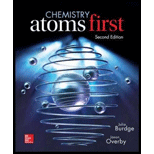
(a)
Interpretation:
The chemical formula of given compounds has to be derived.
Concept introduction:
Rules for deriving chemical formula:
1. Identify the chemical symbols of ions in the compound.
2. Find out the oxidation state of ions.
3. Balance the charges to get neutral compound. Use only subscript to show number of ions.
(b)
Interpretation:
The chemical formula of given compounds has to be derived.
Concept introduction:
Rules for deriving chemical formula:
1. Identify the chemical symbols of ions in the compound.
2. Find out the oxidation state of ions.
3. Balance the charges to get neutral compound. Use only subscript to show number of ions.
(c)
Interpretation:
The chemical formula of given compounds has to be derived.
Concept introduction:
Rules for deriving chemical formula:
1. Identify the chemical symbols of ions in the compound.
2. Find out the oxidation state of ions.
3. Balance the charges to get neutral compound. Use only subscript to show number of ions.
(d)
Interpretation:
The chemical formula of given compounds has to be derived.
Concept introduction:
Rules for deriving chemical formula:
1. Identify the chemical symbols of ions in the compound.
2. Find out the oxidation state of ions.
3. Balance the charges to get neutral compound. Use only subscript to show number of ions.
(e)
Interpretation:
The chemical formula of given compounds has to be derived.
Concept introduction:
Rules for deriving chemical formula:
1. Identify the chemical symbols of ions in the compound.
2. Find out the oxidation state of ions.
3. Balance the charges to get neutral compound. Use only subscript to show number of ions.
(f)
Interpretation:
The chemical formula of given compounds has to be derived.
Concept introduction:
Rules for deriving chemical formula:
1. Identify the chemical symbols of ions in the compound.
2. Find out the oxidation state of ions.
3. Balance the charges to get neutral compound. Use only subscript to show number of ions.
(g)
Interpretation:
The chemical formula of given compounds has to be derived.
Concept introduction:
Rules for deriving chemical formula:
1. Identify the chemical symbols of ions in the compound.
2. Find out the oxidation state of ions.
3. Balance the charges to get neutral compound. Use only subscript to show number of ions.
(h)
Interpretation:
The chemical formula of given compounds has to be derived.
Concept introduction:
Rules for deriving chemical formula:
1. Identify the chemical symbols of ions in the compound.
2. Find out the oxidation state of ions.
3. Balance the charges to get neutral compound. Use only subscript to show number of ions.
Want to see the full answer?
Check out a sample textbook solution
Chapter 5 Solutions
Chemistry: Atoms First
- Write the chemical formulas for the following compounds:(a) aluminum hydroxide, (b) potassium sulfate, (c) copper(I)oxide?arrow_forwardWrite the formulas for the following ionic compounds: (a) copper bromide (containing the Cu+ ion), (b) manganese oxide (containing the Mn3+ ion), (c) mercury iodide (containing the Hg2 2+ ion), (d) magnesium phosphate (containing the PO4 3− ion).arrow_forwardWrite the chemical formulas for (a) potassium sulfide, (b) calcium hydrogen carbonate c) nickel(II) perchlorate. for (d) silicon tetrabromide, (e) disulfur dichloride.arrow_forward
- Write the formulas of the following compounds:(a) lithium carbonate(b) sodium perchlorate(c) barium hydroxide(d) ammonium carbonate(e) sulfuric acid(f) calcium acetate(g) magnesium phosphate(h) sodium sulfitearrow_forwardWhich of the following are ionic, and which are molecular?(a) PF5, (b) NaI, (c) SCl2, (d) Ca1NO322, (e) FeCl3, (f) LaP,(g) CoCO3, (h) N2O4.arrow_forward3. Give the formulas for the following ionic compounds: (b) iron(II) nitrate (a) beryllium sulfate (c) nickel(II) hydroxide (e) lithium phosphate (d) potassium chloride (f) sodium hydrogen sulfatearrow_forward
- Water and sodium chloride are both considered substances as well as compounds, but water exists as molecules while sodium chloride does not. (i) Explain this difference in the behavior of water and sodium chloride. As part of your explanation, (ii) define the terms substance, molecule, and compound.arrow_forward1. A student wrote the formula for an ionic compound of titanium as Ti2O4. What is wrong with this formula? What should the formula be? 2.What are the formulas of the ions formed by (a) iron,(b) cobalt, (c) mercury, (d) chromium, (e) tin, and(f) manganese?arrow_forwardName the following ionic compounds: (a) K,Cr,O7, (b) Li,C,O4, (c) CUNO3.arrow_forward
- What are the formulas of the ions formed by (a) iron,(b) cobalt, (c) mercury, (d) chromium, (e) tin, and(f) manganese?arrow_forwardWrite the formulas for the following compounds:(a) phosphorus pentachloride(b) dinitrogen monoxide(c) iodine heptafluoride(d) carbon tetrachloridearrow_forwardPart one: Write the names of the following compounds. Show all of your work to get full credit. (a) NaNO2 (b) Fe(OH)2 (c) P2O5 Write the formulas for the following compounds. (d) Potassium Carbonate (e) Chromium(III) Sulfate (f) Silicon disulfidearrow_forward
 Chemistry: The Molecular ScienceChemistryISBN:9781285199047Author:John W. Moore, Conrad L. StanitskiPublisher:Cengage Learning
Chemistry: The Molecular ScienceChemistryISBN:9781285199047Author:John W. Moore, Conrad L. StanitskiPublisher:Cengage Learning Chemistry: Principles and PracticeChemistryISBN:9780534420123Author:Daniel L. Reger, Scott R. Goode, David W. Ball, Edward MercerPublisher:Cengage Learning
Chemistry: Principles and PracticeChemistryISBN:9780534420123Author:Daniel L. Reger, Scott R. Goode, David W. Ball, Edward MercerPublisher:Cengage Learning

